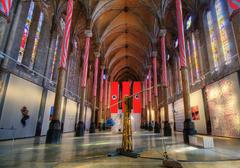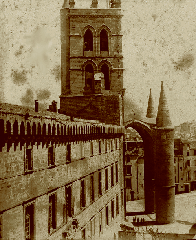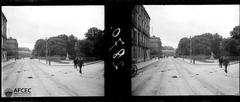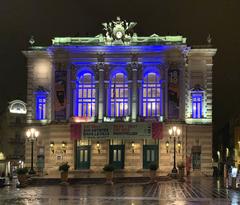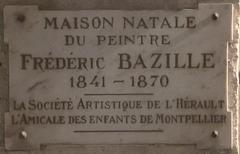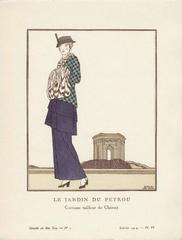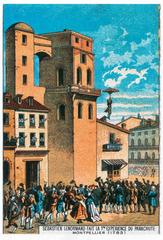Stade Richter Montpellier: Visiting Hours, Tickets, and Comprehensive Visitor Guide
Date: 04/07/2025
Introduction: History and Significance
Stade Richter, located in Montpellier, France, was once the heartbeat of the city’s sports and cultural scene. Constructed in the late 1960s to accommodate a burgeoning football culture and a growing population, the stadium quickly became a pivotal venue for both local sporting events and international concerts. Hosting teams such as Stade Olympique Montpelliérain and the now-renowned Montpellier Hérault Sport Club (MHSC), Stade Richter represented modernity and community pride. In the 1980s, it gained further acclaim as a concert venue, with legendary performances by artists like Bruce Springsteen, U2, and Michael Jackson (dbpedia.org; fr-academic.com; setlist.fm).
The late 1980s ushered in new priorities for Montpellier. The emergence of modern venues, such as Stade de la Mosson and Zénith Sud, led to Stade Richter’s gradual decline, culminating in its demolition in 1990. The stadium’s site was subsequently redeveloped into the ZAC Richter district—a vibrant urban area that now blends academic institutions, residences, and green spaces. This transformation is a testament to Montpellier’s dedication to modernization and cultural vitality, all while honoring the memory of Stade Richter (PSS-archi; France.fr).
Today, while the stadium is gone, visitors can experience the spirit of Stade Richter through the district’s modern amenities and nearby attractions, such as the University of Montpellier I, Place de la Comédie, Musée Fabre, and Promenade du Peyrou. Montpellier’s lively festival calendar continues to echo the communal spirit that once filled the stands of Stade Richter (Montpellier Tourisme; Adventure Backpack).
Table of Contents
- Introduction: History and Significance
- Origins and Construction
- Sporting Heritage
- Cultural Impact and Major Events
- Urban Transformation and Demolition
- Visitor Information
- Stade Richter’s Legacy in Montpellier
- FAQ
- Practical Visitor Information
- Visuals and Media
- Internal Links
- Further Exploration
- Useful Links
- Summary and Visitor Recommendations
- References
Origins and Construction
Stade Richter was developed in the 1960s to address Montpellier’s need for a modern sports venue. The stadium was built on land owned by the Richter family, who previously ran a nursery on the site. Construction began in the mid-1960s, with the official opening in 1968. Designed as a multi-purpose facility, Stade Richter could accommodate up to 30,000 spectators, making it one of the largest stadiums in the region at the time (fr.wikipedia.org; dbpedia.org).
Sporting Heritage
Stade Richter quickly became the home ground for Montpellier’s main football clubs, including Stade Olympique Montpelliérain and, later, Montpellier Hérault Sport Club (MHSC). The stadium hosted league matches, cup games, and local derbies, playing a central role in the city’s football culture between 1968 and the mid-1970s. After MHSC relocated to Stade de la Mosson in 1974, Stade Richter gradually ceased to host major sporting events (fr-academic.com; dbpedia.org).
Cultural Impact and Major Events
In the 1980s, Stade Richter emerged as a premier concert venue, attracting world-renowned artists such as Bruce Springsteen, U2, Pink Floyd, and Michael Jackson (setlist.fm). These large-scale events drew tens of thousands of fans and elevated Montpellier’s status on the international cultural stage. French stars like Jean-Jacques Goldman and bands such as UB40 and The Pretenders also graced the stadium, making it a central hub for music and entertainment (concertarchives.org).
Urban Transformation and Demolition
As the 1980s came to a close, Stade Richter’s infrastructure became outdated, and the city’s attention shifted to new urban development. The stadium was demolished in 1990, paving the way for the ZAC Richter district—a mixed-use area featuring academic institutions, residential buildings, and green spaces. This redevelopment reflected Montpellier’s ongoing commitment to urban renewal and modernization (fr.wikipedia.org; PSS-archi).
Visitor Information
Can You Visit Stade Richter?
The original Stade Richter no longer exists. Instead, the area has been transformed into a vibrant urban district. While you cannot tour the former stadium, the site offers much for visitors interested in urban history, architecture, and local culture.
Nearby Attractions
- University of Montpellier I: Located on the former stadium site, the university is a hub for academic life and occasional public events.
- Place de la Comédie: Montpellier’s main square, known for its lively atmosphere and historical buildings.
- Musée Fabre: The city’s premier art museum, with collections spanning from the Renaissance to contemporary art.
- Promenade du Peyrou: A scenic park with historic monuments and panoramic city views.
Travel Tips and Accessibility
- Getting There: The ZAC Richter district is centrally located and accessible by tram lines 1 and 3 (stops: “Place de l’Europe” and “Rives du Lez”). Buses and bike paths also serve the area.
- Accessibility: The district is designed for accessibility, with ramps, wide walkways, and pedestrian bridges.
- Visitor Hours & Tickets: The area is a public urban space, open 24/7 with no entrance fees. Museums and other attractions nearby have their own specific hours and ticketing policies.
Stade Richter’s Legacy in Montpellier
Although the stadium itself has been replaced, Stade Richter’s legacy is woven into the city’s identity. The district’s transformation into a modern, community-oriented space mirrors Montpellier’s evolution as a city that values progress, inclusivity, and cultural richness. The memory of iconic football matches and legendary concerts lives on through oral histories, local archives, and community events. Today, the ZAC Richter district is a symbol of Montpellier’s successful blending of heritage and innovation (Montpellier Tourisme; Adventure Backpack).
FAQ
Q: Can I visit Stade Richter today?
A: The stadium was demolished in 1990. Visitors can explore the modern urban district that now occupies the site.
Q: What is located at the former Stade Richter site?
A: The area features academic institutions, residential apartments, green spaces, and commercial establishments.
Q: Are there commemorations or markers for Stade Richter?
A: There are no official monuments, but the site’s history is remembered through local stories, university events, and occasional guided tours.
Q: How can I reach the site?
A: Use Montpellier’s tram lines 1 or 3. Stops “Place de l’Europe” and “Rives du Lez” are closest to ZAC Richter.
Practical Visitor Information
- Opening Hours: The ZAC Richter district is accessible at all times.
- Accessibility: The neighborhood is designed for wheelchair and stroller access.
- Tickets: No tickets are required for general access. Museum entry and special events may require tickets.
- Best Time to Visit: During festivals or university events for a lively atmosphere.
Visuals and Media
Enhance your visit with historical images, interactive district maps, and virtual tours. Recommended alt tags for images include “Stade Richter Montpellier historic site,” “ZAC Richter district and university,” and “Passerelle des Barons de Caravètes pedestrian bridge.”
Internal Links
Further Exploration
To delve deeper into Montpellier’s sporting history, trace MHSC’s journey from Stade Richter to Stade de la Mosson and explore the city’s evolving urban landscape. Walking tours and local archives provide additional context and stories (PSS-archi).
Useful Links
- Official Montpellier Tourism
- University of Montpellier Faculty of Economics and Management
- Montpellier Tram Network Info
Summary and Visitor Recommendations
Stade Richter remains a compelling chapter in Montpellier’s history—a symbol of the city’s growth, sporting spirit, and cultural ambition. From its origins as a state-of-the-art stadium to its present role as a vibrant urban district, the site reflects Montpellier’s ability to honor its rich past while embracing the future. Visitors can easily access the area via public transport, explore its green spaces and university facilities, and enjoy nearby historical attractions. For a comprehensive experience, consider joining a guided walking tour or using the Audiala app for audio-guided exploration and event updates. Stade Richter’s story illustrates Montpellier’s ongoing journey as a city where history, community, and innovation meet (dbpedia.org; PSS-archi; France.fr; Montpellier Tourisme; Adventure Backpack).
References
- Stade Richter, 2025, DBpedia
- Stade Richter Montpellier History, 2025, fr-academic.com
- Concerts at Stade Richter, 2025, setlist.fm
- Montpellier Tourism Official Site, 2025
- Montpellier Culture Overview, 2025, Adventure Backpack
- Stade Richter Urban Renewal, 2025, PSS-archi
- Montpellier Urban Development, 2025, France.fr
- Montpellier Festival Calendar, 2025, Montpellier Evous
- Tour de France 2025 in Montpellier, 2025, Montpellier Tourisme
